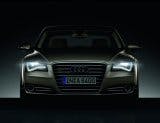The LEDs are “zero-maintenance” and designed for the life of the vehicle. They also have low power consumption. The low beams, for example, consume only 40 watts per unit, a bit less than the already highly efficient xenon plus headlights.
The low beams comprise 10 individual lens modules extending through the headlight in a distinctive arc known as the “wing” owing to its shape. Just below this is another arc of 22 white and 22 yellow LEDs for the daytime running lights (DRLs) and the turn signals. These appear to the viewer as homogenous, continuous strips of light.
Located above the “wing” are the high beams, whose light is generated by two powerful four-chip LEDs and a free surface reflector system. An assistance function switches between the low beams and the high beams. Additional high-output LEDs generate the highway light and the cornering light. A separate fan and heat sink regulate the temperature of each headlight unit and prevent condensation.
With the exception of the reversing light, the tail lights are realized entirely with LED technology, with each unit containing 72 LEDs. The designers used chip-on-board LEDs, which can be packed tightly together with high precision, in many areas due to the limited amount of space available.
The A8 also has an optional ambient lighting package. LEDs will illuminate the center console, tunnel, door pockets and door sill trim. Drivers can choose from three interior LED colors (Polar, Ruby, and Ivory), and can also change the brightness via the Audi Multimedia Interface (MMI).
LED rear lights on VW Golf
As well as providing a very distinctive look, VW says that the response time when braking is 0.2 seconds faster than for conventional incandescent lights. At a speed of 100 km/h, this is equivalent to 5.6 meters braking distance.










